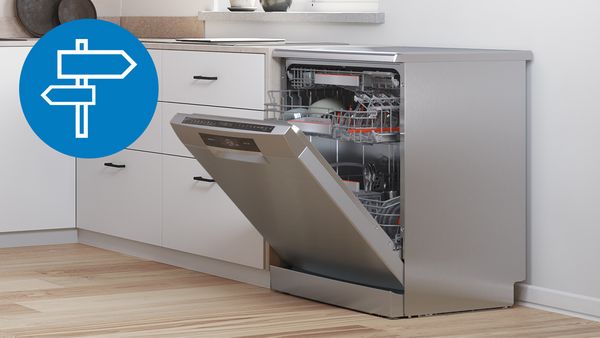Dishwasher has transformed kitchen tasks, offering a streamlined and effective method for cleaning soiled dishes. Incorporating dishwashers into kitchens not only conserves excessive household work but also saves energy. In contrast to handwashing, dishwashers utilize less water. Yet, it's imperative to employ your dishwasher properly for peak performance.
From the moment you load your dirty dishes to the moment they emerge sparkling clean, dishwashers employ a clever blend of engineering and chemistry to get the job done efficiently.
Let’s dive into the inner workings of this household hero and understand the complete process of how to use dishwasher in the best effective way.
1. Loading and Pre-rinsing:
The dishwasher cycle begins with loading the dirty dishes into racks carefully designed to optimize water flow and ensure thorough cleaning. While modern dishwashers are equipped to handle most food residues, it's still a good practice to scrape off excess food particles before loading. Some dishwashers even come with a pre-rinse feature, which sprays water on dishes before the main wash cycle, further loosening stubborn stains.
2. Water Entry and Heating:
Once loaded, the dishwasher door is closed, and the cycle initiated. The first step involves filling the dishwasher's tub with water. This water is then heated to an optimal temperature, typically between 120°F to 140°F (49°C to 60°C). The heating process not only aids in dissolving detergent but also helps in breaking down grease and grime on the dishes.
3. Detergent Dispensing:
As the water reaches the desired temperature, detergent is dispensed into the dishwasher. Modern dishwashers often have separate compartments for detergent, rinse aid, and sometimes even specialized detergents for different types of loads. The detergent mixes with the hot water, forming a cleaning solution that will effectively remove stains and food residues from the dishes.
4. Washing and Rinsing:
Once the detergent is dispensed, the main wash cycle begins. Water, propelled by a pump, is sprayed onto the dishes from strategically placed jets. The force of the water, combined with the detergent solution, dislodges and removes food particles and stains from the dishes' surfaces. Depending on the dishwasher model and settings, there may be multiple wash and rinse cycles to ensure thorough cleaning.
5. Drainage:
After the washing and rinsing stages are complete, the dirty water is drained from the dishwasher tub. Most dishwashers are equipped with a filter to catch large food particles and prevent them from clogging the drainage system. The drained water is then pumped out of the dishwasher, making way for the next stage of the cycle.
6. Drying:
Once the dishes are clean and the water drained, the final step is drying. There are several methods used for drying dishes in dishwashers. Some models use a heating element to evaporate remaining water, while others employ a fan to circulate air and aid in the drying process. Rinse aid is often used during this stage to speed up drying and prevent water spots on dishes.
7. End of Cycle:
With the dishes clean and dry, the dishwasher cycle comes to an end. Many modern dishwashers feature indicators, such as lights or beeps, to signal when the cycle is complete. Once the cycle finishes, the clean dishes can be unloaded and put away, ready for their next use.
Using Dishwasher for the first time? Here is the beginner’s guide
If you've recently acquired a dishwasher and find yourself staring at its sleek exterior with a mixture of excitement and apprehension, fear not. Here's a comprehensive guide to help you navigate your first journey into the world of dishwasher operation.
Select your own Dishwasher with Bosch
1. Read the Manual: Before diving in, take a moment to read the manufacturer's manual. Each dishwasher model may have specific features, settings, and instructions that you should be aware of. Understanding the unique functions of your machine will ensure optimal performance and longevity.
2. Preparation: Start by scraping off excess food from your dishes. While modern dishwashers are powerful, they're not equipped to handle large food particles. Additionally, check for any labels or stickers on new dishes and remove them, as they can interfere with the cleaning process.
3. Loading: Proper loading is key to efficient cleaning. Arrange dishes in the racks, ensuring that they are not overcrowded. Place larger items such as pots and pans on the lower rack, while cups, glasses, and smaller items should go on the upper rack. Utensils can be placed in the designated basket, with handles facing downward for optimal cleaning.
4. Detergent Selection: Choose a dishwasher detergent suitable for your machine and water hardness. Follow the manufacturer's recommendations regarding the amount of detergent to use. Using too much detergent can result in residue buildup, while using too little may leave dishes dirty.
5. Selecting Wash Cycle: Most dishwashers offer a variety of wash cycles tailored to different needs. Common options include normal, heavy-duty, eco-friendly, and quick wash cycles. Select the appropriate cycle based on the level of soiling and the type of dishes being washed.
6. Additional Options: Many dishwashers come equipped with additional options such as heated drying, sanitize, and delay start. Familiarize yourself with these options and choose as needed. For example, the sanitize option is ideal for ensuring that dishes are thoroughly disinfected, while the delay start feature allows you to schedule wash cycles at a convenient time.
7. Start the Cycle: Once you've loaded the dishwasher, selected the wash cycle, and adjusted any additional options, it's time to start the cycle. Simply close the dishwasher door securely and press the start button. Sit back and relax as your dishwasher takes care of the rest.
8. Post-Cycle Care: After the wash cycle is complete, allow some time for the dishes to cool before unloading them. Be cautious when handling hot dishes, and use oven mitts if necessary. Once unloaded, wipe down the interior of the dishwasher with a clean cloth to remove any residual moisture and prevent mold growth.
9. Maintenance: Regular maintenance is essential for keeping your dishwasher in top condition. Clean the filter periodically to remove trapped food particles, and check the spray arms for any obstructions. Additionally, run a cleaning cycle with dishwasher cleaner or vinegar to remove built-up residue and maintain optimal performance.
By following these simple steps, you can confidently use your dishwasher for the first time and enjoy the convenience of effortlessly clean dishes. With a little practice, operating your dishwasher will become second nature, allowing you to spend less time on chores and more time on the things that matter most.
How to Load the Dishwasher?
Loading the dishwasher efficiently is crucial for maximizing its capacity and ensuring thorough cleaning.
- Begin by scraping off excess food from dishes to prevent clogs and optimize washing performance.
- Arrange items strategically, placing larger items like pots and pans on the bottom rack, while positioning plates, bowls, and glasses on the upper rack.
- Be mindful to not overcrowd the dishwasher, leaving space between items for water and detergent to circulate effectively.
- Place utensils in the designated utensil basket, ensuring they don't nest together to allow water to reach all surfaces.
- Lastly, check for any items that are not dishwasher-safe and hand wash them separately. With a well-organized approach, loading the dishwasher becomes an efficient task that results in sparkling clean dishes with each cycle.
Can Dishwasher Clean Indian Utensils
Yes, dishwashers can clean Indian utensils just like any other type of utensil. Dishwasher for Indian kitchen offers you several benefits. However, there are certain things you should keep in mind such as material compatibility, food residue & more..
Material Compatibility: Ensure that the Indian utensils you're putting in the dishwasher are dishwasher-safe. Most stainless steel, glass, and ceramic utensils should be fine, but certain materials like copper or brass may not be suitable for dishwashers as they can tarnish or discolor.
Food Residue: Some Indian cooking may involve more oily or sticky residues compared to Western cuisines. It's a good idea to scrape off excess food before loading the utensils into the dishwasher. Pre-rinsing can also help ensure better cleaning results.
Spices and Stains: Indian spices and ingredients can sometimes leave stains or odors on utensils. Dishwashers generally do a good job of removing these, but for particularly stubborn stains, pre-soaking or pre-treating may be necessary.
Delicate Items: Certain delicate Indian utensils, like intricately designed serving bowls or hand-painted dishes, may be better washed by hand to preserve their aesthetics.
Overall, as long as the utensils are dishwasher-safe and any excess food residue is removed, dishwashers can effectively clean Indian utensils just like any other type of cookware.





